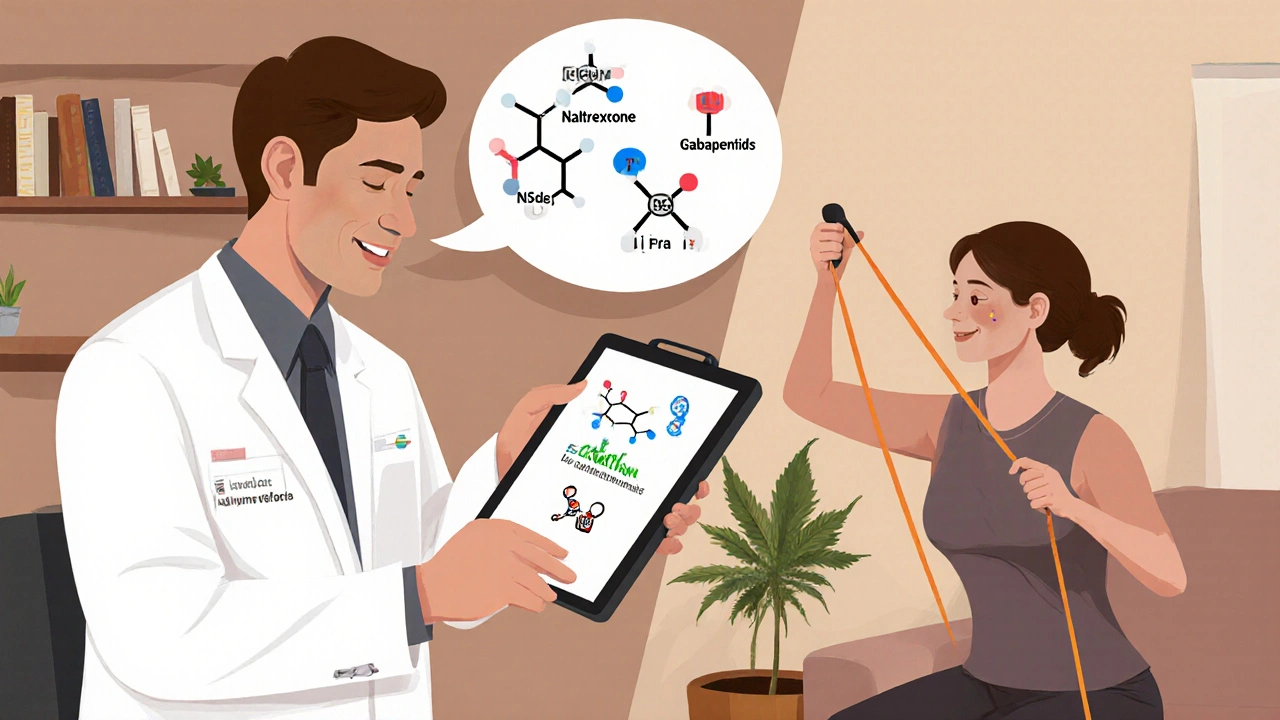LDN vs Alternatives Comparison Tool
Select your primary concern and preferred treatment approach to see how LDN compares to common alternatives.
Low Dose Naltrexone is a low‑dose (1‑4.5mg) formulation of the opioid antagonist naltrexone, used off‑label for immune modulation, chronic pain and certain autoimmune disorders.
Naltrexone (standard dose 50‑100mg) is an FDA‑approved opioid antagonist for alcohol dependence and opioid relapse prevention.
Non‑steroidal anti‑inflammatory drugs (NSAIDs) are a class of analgesics that inhibit cyclooxygenase enzymes to reduce inflammation and pain.
Gabapentin is an anticonvulsant repurposed for neuropathic pain and fibromyalgia.
Cannabinoids (e.g., THC, CBD) act on the endocannabinoid system and are used for spasticity, pain and sleep disorders.
Physical therapy encompasses exercise, manual techniques and modalities aimed at restoring function and reducing pain without medication.
Immune modulation describes interventions that adjust immune system activity, either dampening over‑activity or enhancing deficient responses.
Clinical trial evidence refers to data gathered from controlled studies that assess safety, efficacy and dosage parameters.
TL;DR - Quick Takeaways
- LDN works by briefly blocking opioid receptors, triggering a rebound increase in endorphins and immune‑regulating pathways.
- Typical LDN dose: 1.5mg at bedtime; most users report mild, transient side effects.
- NSAIDs provide fast pain relief but carry GI, cardiovascular and renal risks with long‑term use.
- Gabapentin is effective for neuropathic pain but can cause dizziness, edema and dose‑dependent sedation.
- Cannabinoids offer spasticity control and sleep aid, yet legal status and product consistency vary widely.
- Physical therapy has no drug‑related adverse events and improves function, but requires regular commitment.
What Makes Low Dose Naltrexone Different?
At a Low Dose Naltrexone level, the drug does not fully block opioid receptors. Instead, it creates a brief blockade lasting 2‑3hours, after which the body compensates by up‑regulating endogenous opioids (endorphins) and increasing CD4+ T‑cell activity. This paradoxical rebound is thought to dampen pro‑inflammatory cytokines such as TNF‑α and IL‑6, which are central to conditions like multiple sclerosis, Crohn’s disease and fibromyalgia.
Because the dose is tiny, the classic side‑effects of full‑dose naltrexone-nausea, hepatotoxicity, opioid withdrawal-are rarely seen. Most reported complaints are vivid dreams or mild insomnia, usually resolved by taking the dose earlier in the evening.
How the Alternatives Work
Understanding the mechanisms of the most common alternatives helps clinicians match treatment to the underlying pathology.
- NSAIDs inhibit COX‑1 and COX‑2 enzymes, reducing prostaglandin synthesis. This directly lessens inflammation but does not address immune dysregulation.
- Gabapentin binds to the α2δ subunit of voltage‑gated calcium channels, decreasing excitatory neurotransmitter release. It targets neuropathic pathways rather than systemic inflammation.
- Cannabinoids activate CB1 and CB2 receptors. CB2 activation produces anti‑inflammatory effects, while CB1 modulates pain perception and muscle tone.
- Physical therapy promotes neuroplasticity, improves circulation, and reduces mechanical stress on joints, offering symptom relief without pharmacologic action.
Key Attributes of Each Option
| Attribute | LDN (1‑4.5mg) | NSAIDs | Gabapentin | Cannabinoids | Physical Therapy |
|---|---|---|---|---|---|
| Typical Dose | 1.5mg nightly | 200‑800mg q6‑8h | 300‑1800mg daily | 10‑30mg THC/CBD daily | 30‑60min sessions 2‑3×/wk |
| Primary Mechanism | Opioid‑receptor rebound → endorphin ↑ & immune modulation | COX inhibition → prostaglandin ↓ | Calcium‑channel modulation → neuropathic pain ↓ | CB1/CB2 activation → analgesia & anti‑inflammation | Exercise‑induced neuroplasticity & biomechanical correction |
| FDA Status (US) | Off‑label use (approved for opioid/alcohol dependence) | Approved OTC or prescription | Prescription | Schedule I (THC) / OTC (CBD) - variable | Non‑drug therapy |
| Evidence Level (2023‑2024) | Small RCTs, real‑world cohorts - moderate | Large meta‑analyses - high for acute pain | Multiple RCTs - high for neuropathic pain | Emerging RCTs - low‑moderate | Systematic reviews - high for functional outcomes |
| Common Side Effects | Dream vividness, insomnia (transient) | GI upset, ulcer, renal strain | Dizziness, edema, weight gain | Dry mouth, psycho‑active effects, dizziness | Muscle soreness, fatigue (initial) |
Clinical Evidence: When Does LDN Shine?
Recent systematic reviews (2022‑2024) show that LDN improves disease‑specific outcomes in multiple sclerosis (reduced relapse rate by ~30%), Crohn’s disease (clinical remission ↑ 20%), and fibromyalgia (pain scores ↓ 2‑3 points on VAS). These benefits are most pronounced in patients who have failed at least one conventional disease‑modifying drug.
By contrast, NSAIDs dominate acute inflammatory flares but lack disease‑modifying impact. Gabapentin excels in established neuropathic pain but does not affect underlying immune dysregulation. Cannabinoids have mixed results; they help spasticity in MS but evidence for broader autoimmune pain remains limited. Physical therapy consistently improves functional scores and quality of life, though it seldom alters inflammatory biomarkers.

Decision Framework: Picking the Right Tool
- Identify the primary driver of symptoms. If pain stems from immune over‑activity, LDN or cannabinoids (CB2) may address the root cause. If pain is purely mechanical, physical therapy or NSAIDs are more appropriate.
- Assess comorbidities and drug interactions. Patients on anticoagulants should avoid chronic NSAIDs; those with renal impairment may favor LDN or PT.
- Consider regulatory and cost factors. LDN is inexpensive (often compounded) but requires a prescriber familiar with off‑label use. Cannabinoids may be costly and have variable insurance coverage.
- Evaluate patient preference. Some patients reject any medication and prefer PT; others seek a single pill solution.
- Plan for monitoring. LDN requires baseline liver tests and periodic symptom scoring. NSAIDs demand GI protection strategies; gabapentin needs renal function checks.
Practical Tips for Starting LDN
- Begin with 0.5mg nightly for the first week, increase by 0.5mg each week to a target 1.5‑4.5mg.
- Take the dose 2‑3hours before bedtime to reduce vivid dreams.
- Monitor pain scores, fatigue, and any new GI symptoms for the first 30days.
- Coordinate with a pharmacist to ensure the compounding pharmacy follows USP‑sterile guidelines.
- Review liver enzymes at baseline and at 3‑month intervals.
Related Concepts and How They Intersect
Understanding the broader landscape helps you communicate clearly with patients and other clinicians.
- Off‑label prescribing is when a medication is used for an indication not approved by the FDA, relying on clinical evidence and professional judgment.
- Endorphin rebound refers to the increase in natural opioid peptides after brief receptor blockade, a key step in LDN’s mechanism.
- Cytokine modulation describes how certain drugs (e.g., LDN, cannabinoids) lower pro‑inflammatory cytokines, potentially altering disease progression.
- Long‑term safety data for LDN remains limited; most studies max out at 12‑18months, so ongoing surveillance is essential.
- Compounding pharmacy standards ensure the precise low‑dose formulation required for LDN, as commercial tablets are typically 50mg.
When LDN Might Not Be the Best Choice
Despite its promise, LDN is not a universal cure. Consider alternative pathways when:
- The patient is actively using opioid analgesics-LDN can precipitate withdrawal.
- Pregnancy or breastfeeding is planned; safety data are insufficient.
- Insurance denies coverage for compounding; out‑of‑pocket cost becomes prohibitive.
- Rapid pain relief is needed; NSAIDs or short‑acting opioids act faster than LDN’s immunologic effects.
Future Directions: Emerging Alternatives
Research pipelines include selective Toll‑like receptor 4 (TLR‑4) antagonists, low‑dose IL‑6 blockers, and oral micro‑doses of psychedelics aimed at neuro‑immune recalibration. While these are still experimental, they underscore growing interest in non‑conventional, immune‑focused pain management.
Frequently Asked Questions
What is the typical dosage range for Low Dose Naltrexone?
Most clinicians start patients at 0.5mg nightly and titrate up to 1.5‑4.5mg, taken 2‑3hours before bed. The exact target depends on the condition being treated and individual tolerance.
Are there any drug interactions with LDN?
Because the dose is low, major interactions are rare. However, concurrent opioid use can trigger withdrawal, and certain immunosuppressants may have additive effects on cytokine pathways. Always review the full medication list.
How does LDN compare to NSAIDs for chronic pain?
NSAIDs provide quick relief by dampening prostaglandin‑mediated inflammation but do not modify underlying immune dysfunction. LDN works slower, targeting the immune system and endogenous opioid production, offering potential disease‑modifying benefits with fewer GI or cardiovascular risks.
Can LDN be used alongside physical therapy?
Yes, they complement each other. LDN may reduce pain and fatigue, allowing patients to engage more effectively in PT sessions, while PT improves function and reduces mechanical stress on joints.
What monitoring is required for long‑term LDN use?
Baseline liver function tests are recommended, followed by repeat testing at three months and then annually. Symptom questionnaires (pain VAS, fatigue scales) help gauge effectiveness and guide dose adjustments.


Author
Mike Clayton
As a pharmaceutical expert, I am passionate about researching and developing new medications to improve people's lives. With my extensive knowledge in the field, I enjoy writing articles and sharing insights on various diseases and their treatments. My goal is to educate the public on the importance of understanding the medications they take and how they can contribute to their overall well-being. I am constantly striving to stay up-to-date with the latest advancements in pharmaceuticals and share that knowledge with others. Through my writing, I hope to bridge the gap between science and the general public, making complex topics more accessible and easy to understand.